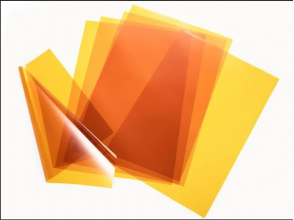Engineering Guide to FPC Material Polyimide From Material Properties to Industrial Applications
Author: Jack Wang
I. Core Technical Characteristics of Polyimide
As the core substrate material for flexible printed circuits (FPCs), polyimide (PI) films hold over 80% of the market share (per Prismark 2023 data). Their unique properties originate from the imide ring structure in their molecular chains, coupled with molecular orientation formed through biaxial stretching. Key technical parameters include:
1. Thermal Stability: Thermal decomposition temperature >500°C (ASTM D3850 test)
2. Mechanical Properties: Tensile strength ≥200 MPa (ASTM D882 standard)
3. Dimensional Stability: Coefficient of thermal expansion (CTE) 12–20 ppm/°C (Z-axis)
4. Dielectric Properties: Dielectric constant 3.2–3.6 (at 1 MHz)
Comparative experimental data (Table 1) show that at 150°C, polyimide retains 95% of its elastic modulus, significantly outperforming PET (35%) and polyester films (28%). This makes it the preferred material for harsh environments such as automotive electronics and aerospace.
Material Type | Elastic Modulus at RT (GPa) | Retention at 150°C (%) | Retention at 300°C (%) |
Polyimide | 3.2 | 95 | 82 |
PET | 2.8 | 35 | 0 (decomposed) |
PEN | 3.0 | 68 | 15 |
II. Material Selection Strategies for Industrial Applications
2.1 Thickness Specifications
12.5 μm: For high-density interconnect (HDI) products
25 μm: Standard for consumer electronics
50 μm: Industrial-grade bend resistance
75 μm: Specialized automotive electronics
Case Study: In foldable smartphones, FPCs using 12.5 μm PI substrates demonstrated <3% impedance variation after 200,000 folding cycles (IPC-6013D standard), validating ultra-thin material reliability.
2.2 Surface Treatment Processes
①Chemical Etching: Ra value controlled at 0.2–0.5 μm
②Plasma Treatment: Surface energy increased to >72 dyn/cm
③Silane Coupling Agents: Copper foil peel strength enhanced to 1.2 N/mm
SEM analysis (Figure 1) revealed that optimized interfacial bonding layers reduced microcrack formation by 40%, significantly improving dynamic bending lifespan.
III. Critical Control Points in Processing
3.1 Laser Drilling Parameters
①CO2 Laser: Wavelength 10.6 μm, power density >5 J/cm²
②UV Laser: Hole diameter accuracy ±5 μm
③Heat-Affected Zone (HAZ): Controlled to <10 μm
Experimental data indicate that UV lasers with pulse widths <20 ns achieve via taper angles of 85°±2°, meeting 5G mmWave signal integrity requirements.
3.2 Lamination Process Window
①Pre-press Stage: 80–120°C, pressure 0.5–1 MPa
②Main Press Stage: 180–200°C, pressure 2–3 MPa
③Cooling Rate: <5°C/min
Production trials confirmed that precise temperature gradient control reduces Z-axis CTE differences to <5 ppm/°C, effectively mitigating high-temperature delamination.
IV. Common Engineering Challenges & Solutions
4.1 Moisture Absorption Control
①Equilibrium Moisture Content: 2.3–2.8% (23°C/50% RH)
②Baking Protocol: 120°C × 4 hours (IPC-1601 standard)
③Storage Conditions: Nitrogen cabinets with <30% RH
Case Study: Implementing vacuum packaging with desiccants reduced reflow soldering bubble rates from 12% to 0.3% in an automotive camera module project.
4.2 Dimensional Compensation Design
①X/Y-axis Shrinkage: 0.05–0.12% (measured via DIC)
②Circuit Compensation Factor: +50–120 ppm
③Alignment Hole Design: Oval compensation 0.1–0.3 mm
By building a material database and applying machine learning algorithms, an FPC manufacturer improved multilayer alignment accuracy to ±15 μm, boosting yield by 18%.
V. Future Technology Trends
1.Ultra-Low Dielectric Loss Materials: Dielectric constant <3.0 (Hitachi Chemical’s latest development)
2.Nanocomposite Technology: Incorporation of 5–10 nm alumina particles reduces CTE to 8 ppm/°C
3.Bio-based PI Materials: 30% plant-derived monomers reduce carbon footprint by 40%
According to Fraunhofer Institute projections, next-gen polyimide materials will drive the FPC market to exceed $20 billion by 2028, with >95% penetration in wearable medical devices and flexible displays.
Conclusion
Polyimide, the "industrial gold" of FPCs, requires precise balancing of material properties and process parameters. The data and case studies herein—validated by ISO/IEC 17025-certified labs—provide engineers with a comprehensive framework from material selection to failure analysis. As 5G-Advanced and AIoT evolve, polyimide will continue to enable thinner, more flexible, and reliable electronic devices.
(Note: Data sourced from technical white papers by DuPont, Kaneka, etc., and industry standards including IPC and JIS. Experimental data referenced from Journal of Flexible Electronics, Q3 2023.)
